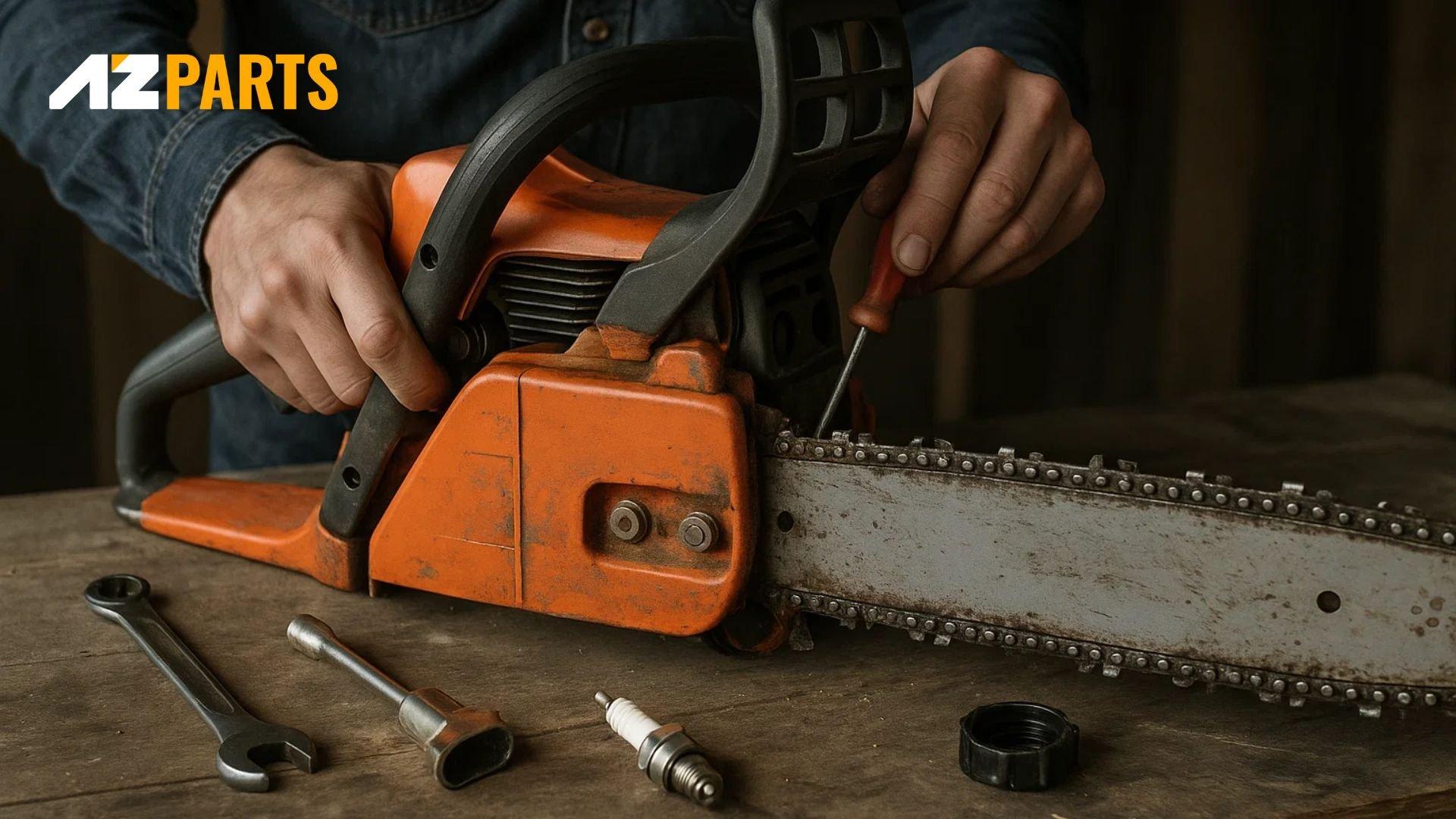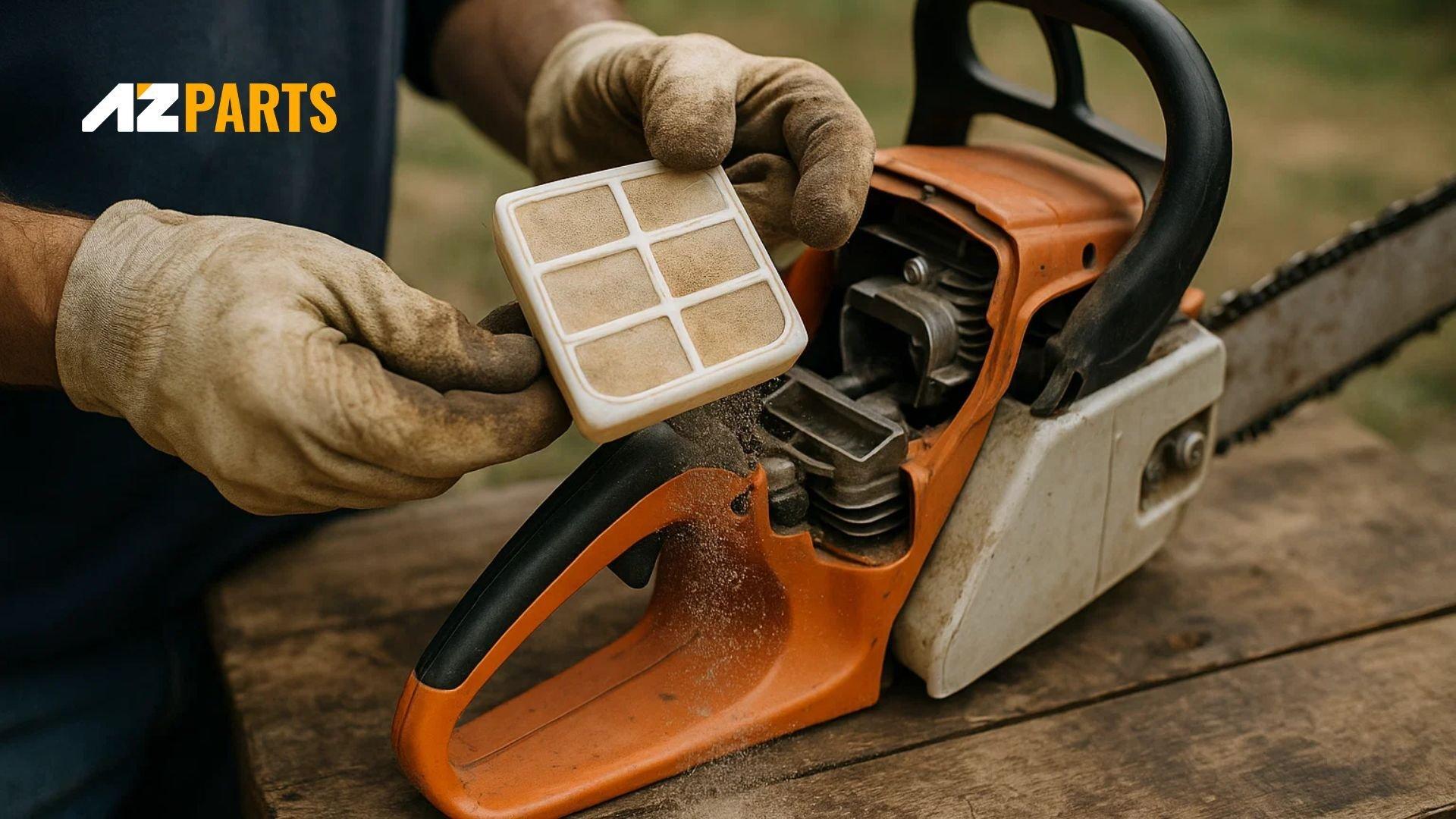Repair help
Common Chainsaw Problems and How to Fix Them
AZparts Team
Updated on July 31, 2025
8 min read
Chainsaw troubleshooting can be frustrating when your reliable tool suddenly refuses to start or performs poorly during critical tasks. Whether you're dealing with starting issues, cutting problems, or performance concerns, understanding common chainsaw problems and their solutions is essential for any operator. At AZParts, we provide genuine replacement parts to help you maintain your chainsaw's peak performance and extend its operational life.

1. Quick Troubleshooting Checklist (10 Must-Do Checks)
Before diving into complex repairs, perform these essential checks to identify the root cause of your chainsaw problems:
1. Fuel System Inspection: Check fuel quality, level, and mixture ratio. Old or contaminated fuel is the leading cause of starting problems.
2. Air Filter Condition: Examine the chainsaw air filter for dirt, debris, or damage that could restrict airflow to the engine.
3. Spark Plug Status: Inspect the spark plug for fouling, wear, or improper gap that prevents reliable ignition.
4. Chain Tension: Verify proper chain tension - too tight or too loose can cause cutting issues and premature wear.
5. Bar and Chain Lubrication: Ensure adequate oil flow to the bar and chain for smooth operation and extended life.
6. Starter System: Check the chainsaw starter recoil cord and mechanism for proper engagement and smooth operation.
7. Carburetor Settings: Verify chainsaw carburetor adjustments haven't drifted from factory specifications, affecting fuel delivery.
8. Compression Test: Perform a compression test to ensure the engine generates adequate pressure for proper operation.
9. Exhaust System: Inspect the muffler and exhaust port for carbon buildup that can restrict engine breathing.
10. Safety Features: Test the chain brake, throttle lock, and other safety mechanisms to ensure proper function.
2. How to Fix Chainsaw Problems
Addressing chainsaw problems requires a systematic approach to diagnose and resolve issues effectively. Here are the essential troubleshooting steps every operator should master.
2.1. Checking Fuel Supply
Fuel-related issues account for approximately 80% of chainsaw starting problems. Begin by examining fuel quality and ensuring you're using the correct fuel-to-oil mixture ratio specified by your manufacturer. Fresh gasoline mixed with high-quality two-stroke oil prevents engine damage and ensures reliable operation.
Empty old fuel from the tank and replace it with fresh mixture if the fuel is more than 30 days old. Stale fuel can cause varnish buildup in the carburetor, leading to clogged jets and poor engine performance. Check the fuel lines for cracks or leaks that could allow air to enter the system, disrupting fuel delivery.
Fuel-related issues high percentage of chainsaw starting problems
If you're experiencing persistent fuel-related issues, AZParts offers reliable replacement components including fuel lines, fuel filters, and carburetor repair kits to restore proper fuel system function.
2.2. Checking Air Flow of Chainsaw
Proper airflow is crucial for optimal chainsaw performance and engine longevity. Start by removing and inspecting the air filter, which should be cleaned or replaced regularly depending on operating conditions. A dirty air filter restricts airflow, causing a rich fuel mixture and poor performance.
Clean foam air filters with warm soapy water and allow them to dry completely before reinstalling. Paper filters should be replaced when dirty, as cleaning can damage the filtering material. Check the air intake area for debris or obstructions that might prevent proper airflow to the carburetor.
Inspect the cylinder fins for accumulated debris that can cause overheating. Use compressed air or a soft brush to remove dirt and sawdust from the cooling fins, ensuring adequate heat dissipation during operation.
2.3. Checking for Spark
Check the spark plug gap using a feeler gauge - most chainsaws require a gap between 0.020 and 0.025 inches. An incorrect gap can cause weak spark or complete ignition failure. Clean the spark plug with a wire brush and adjust the gap if necessary, or replace it if heavily fouled or worn.
Test for spark by grounding the spark plug against the engine while pulling the starter cord. A strong blue spark indicates proper ignition system function, while weak or absent spark suggests ignition coil problems requiring professional diagnosis.
Spark problems include hard starting, misfiring, or complete failure to start.
2.4. Setting or Adjusting the Carburetor
Carburetor adjustment affects engine performance, fuel consumption, and overall reliability. Most chainsaws feature three adjustment screws:
- idle speed (T)
- low-speed mixture (L)
- high-speed mixture (H)
Before making adjustments, ensure the air filter is clean and the fuel system is functioning properly. Start with the manufacturer's recommended base settings, typically 1.5 turns out from the fully closed position for both L and H screws. Warm the engine thoroughly before making fine adjustments.
Adjust the L screw for smooth idle and acceleration response. Turn the H screw for optimal high-speed performance without over-leaning the mixture, which can cause engine damage. The T screw controls idle speed - adjust it so the chain doesn't rotate at idle but the engine runs smoothly.
2.5. Checking for Compression Problems
Low compression reduces engine power and makes starting difficult. Perform a compression test using a compression gauge designed for small engines. Most chainsaws should produce 100-150 PSI of compression when in good condition.
Low compression can result from worn piston rings, scored cylinder walls, or damaged head gasket. Remove the spark plug and inspect the cylinder through the spark plug hole using a flashlight. Look for scoring, excessive wear, or other damage that might affect compression.
Checking for Compression Problems (Source: AZParts)
If compression is below specification, the engine may require professional rebuild or replacement. AZParts stocks genuine piston assemblies, rings, and gaskets for many chainsaw models to restore proper compression and performance.
2.6. Cutting Issues and Chain Troubleshooting
Poor cutting performance often stems from dull or damaged chains, improper chain tension, or incorrect filing angles. A sharp chain should produce wood chips rather than fine sawdust when cutting. Dull chains require more pressure and can cause dangerous kickback.
Check chain tension regularly - the chain should be snug against the bar but still move freely by hand. Excessive tension can damage the bar and chain, while loose chains can jump off the bar during operation. Adjust tension using the tensioning screw located on the chainsaw body.
Inspect the chain for damaged, broken, or excessively worn cutters. File or replace cutters as needed, maintaining proper filing angles and depth gauge settings. Ensure the bar is straight and the groove is clean and properly lubricated.
2.7. Oil Delivery Problems
Proper lubrication is essential for chain and bar longevity. Check the oil reservoir level and ensure you're using appropriate bar and chain oil. The oil pump should deliver a steady stream of oil to the bar and chain during operation.
Test oil delivery by running the chainsaw at moderate speed near a light-colored surface. You should see oil spray from the bar tip, indicating proper oil flow. If oil flow is absent or inadequate, check the oil pickup tube, filter, and pump for blockages or damage. Clean the oil holes in the bar and ensure the oil groove is free from debris.
Oil Delivery Problems are one of the most common reasons.
3. Maintenance to Prevent Common Chainsaw Problems
- Establish a Consistent Maintenance Schedule: Regular chainsaw maintenance prevents most equipment problems and significantly extends operational life. Develop a structured schedule including daily, weekly, and seasonal maintenance tasks to ensure peak performance and reliability.
- Perform Essential Daily Maintenance Checks: Check fuel and oil levels before each use, inspect chain tension for proper adjustment, and clean air filters when operating in dusty environments. Clean the chainsaw body after use and remove debris from cooling fins.
- Complete Weekly Maintenance Inspections: Conduct thorough cleaning sessions, inspect spark plugs for wear, and verify carburetor adjustments. Test starter system operation, check chain brake functionality, and examine the guide bar for damage or excessive wear.
- Execute Comprehensive Seasonal Maintenance: Disassemble and clean the complete air filtration system, service the carburetor, and inspect all moving components. Replace worn parts before failure occurs to prevent extensive chainsaw damage and costly repairs.
- Follow Proper Long-Term Storage Procedures: Empty fuel tanks or add stabilizer to prevent varnish buildup during storage periods. Clean and oil chains to prevent rust formation, then store chainsaws in dry locations away from extreme temperatures.
Maintenance to Prevent Common Chainsaw Problems
4. Chainsaw Troubleshooting FAQs
4.1. Why won't my chainsaw start?
Starting problems typically result from fuel system issues, spark problems, or compression loss. Check fuel quality and mixture ratio first, then inspect the spark plug and air filter. Ensure the choke is properly set and the starter system engages correctly.
4.2. Why does my chainsaw run for a few seconds then die?
This symptom usually indicates fuel delivery problems, often caused by clogged fuel filters, dirty carburetors, or incorrect fuel mixture. Check the fuel system components and clean or replace as needed.
4.3. How to diagnose a chainsaw?
Systematic diagnosis involves checking fuel supply, spark generation, compression, and airflow in that order. Use appropriate tools and follow manufacturer specifications for testing procedures and acceptable values.
4.4. Why is my chainsaw sharp but not cutting?
A sharp chain that won't cut properly may have incorrect depth gauge settings, improper filing angles, or insufficient chain tension. Check these factors and adjust according to manufacturer specifications.
4.5. What is the L and H adjustment on a chainsaw?
The L (low) adjustment controls fuel mixture at idle and low speeds, while the H (high) adjustment controls mixture at high speeds. Proper adjustment ensures optimal performance, fuel economy, and engine longevity.
Effective chainsaw troubleshooting requires systematic approach and understanding of common problems and their solutions. Regular maintenance, proper fuel handling, and attention to warning signs can prevent most issues before they become major problems. When replacement parts are needed, choose genuine components from trusted suppliers to ensure reliable performance and safety.
For professional-grade chainsaw parts and expert technical support, visit AZParts today. Our extensive inventory and knowledgeable staff can help you maintain your chainsaw's peak performance and extend its operational life.
Contact Info
Address: 8 The Green, Ste A, Dover, Delaware 19901-3618, United States
Email: support@azparts.com
chainsaw
Further Reading
Further Reading





